World Regional Geography Assignment: Challenges and Impacts
VerifiedAdded on 2022/08/19
|8
|1961
|16
Homework Assignment
AI Summary
This assignment provides a comprehensive analysis of world regional geography, focusing on four key regions: South America, Sub-Saharan Africa, North Africa/Southwest Asia, and South Asia. The student explores South America's potential for growth, addressing both challenges and opportunities. In Sub-Saharan Africa, the assignment examines the challenges faced by African farmers in food production and analyzes the pros and cons of foreign agribusiness. The role of oil in shaping North Africa and Southwest Asia is discussed, with an assessment of whether it has been a blessing or a curse. Finally, the assignment investigates the impact of economic liberalization in South Asia, evaluating whether the benefits of growth have been equally shared. The analysis draws on specific examples from each realm, referencing relevant literature to support the arguments presented.
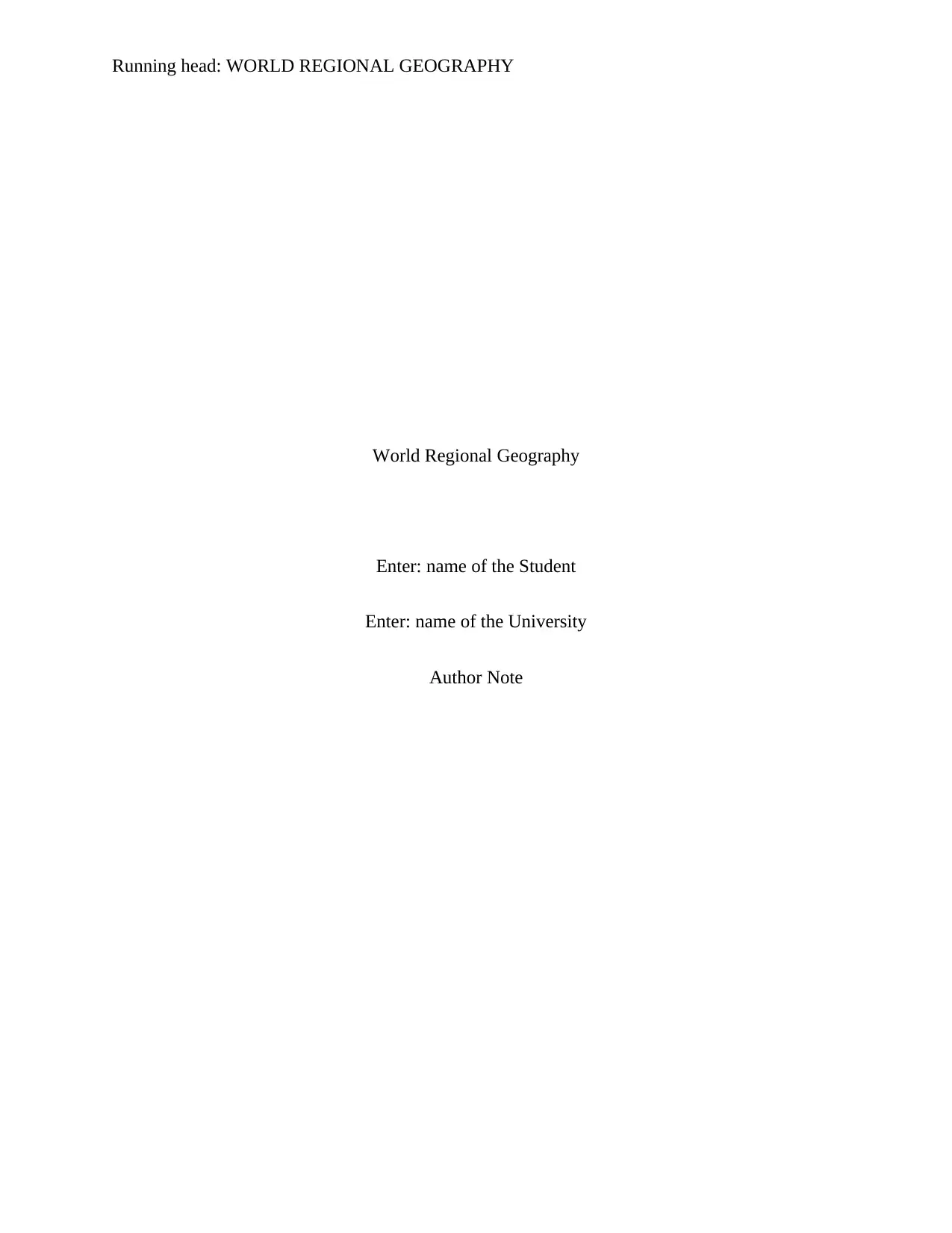
Running head: WORLD REGIONAL GEOGRAPHY
World Regional Geography
Enter: name of the Student
Enter: name of the University
Author Note
World Regional Geography
Enter: name of the Student
Enter: name of the University
Author Note
Paraphrase This Document
Need a fresh take? Get an instant paraphrase of this document with our AI Paraphraser

2WORLD REGIONAL GEOGRAPHY
1: South America: Will South America finally realize its potential in the twenty-first
century? Why?
Yes, South America can finally realize their potential in the 21st century; however, there
are numerous new challenges which are also faced by these countries which were not there in the
earlier centuries. In order to make any kind of significant progress, South America countries
should have a plan to deal with the new challenges. Each of these challenges has to be addressed
in such a manner so that they cannot not only realize their potentials but also grow like the other
developing countries of the world like Russia and China.
In the 21st century, there are numerous new challenges in South America which can be
broadly classified into three categories such as the political, social and economic challenges. The
social challenge of this country is the poverty issue, the economic challenges remains the same
as the 20th century which is increasing competitiveness, and consolidating integration is the most
significant political issues face by the South Americans. The GDP of the South American nations
are much lower than the other developing nations such as India. However, significant economic
growth was observed in countries like Colombia, Argentina and Brazil. These countries
understood their potential much better than the other South American nations like Peru and
Uruguay (Wiarda & Kline, 2018). The employment rate of Brazil is much better than the rest of
the countries, and the economies of the other South American countries are reducing at an
alarming rate. Countries like Argentina is not every much stable as well inspite of realizing its
potential. The monetary policies of the South American countries have to be revised as their
economic conditions are very much dynamic in nature. The state controlled oil firms must be
given a proper roadmap which can contribute more for the development of the South American
1: South America: Will South America finally realize its potential in the twenty-first
century? Why?
Yes, South America can finally realize their potential in the 21st century; however, there
are numerous new challenges which are also faced by these countries which were not there in the
earlier centuries. In order to make any kind of significant progress, South America countries
should have a plan to deal with the new challenges. Each of these challenges has to be addressed
in such a manner so that they cannot not only realize their potentials but also grow like the other
developing countries of the world like Russia and China.
In the 21st century, there are numerous new challenges in South America which can be
broadly classified into three categories such as the political, social and economic challenges. The
social challenge of this country is the poverty issue, the economic challenges remains the same
as the 20th century which is increasing competitiveness, and consolidating integration is the most
significant political issues face by the South Americans. The GDP of the South American nations
are much lower than the other developing nations such as India. However, significant economic
growth was observed in countries like Colombia, Argentina and Brazil. These countries
understood their potential much better than the other South American nations like Peru and
Uruguay (Wiarda & Kline, 2018). The employment rate of Brazil is much better than the rest of
the countries, and the economies of the other South American countries are reducing at an
alarming rate. Countries like Argentina is not every much stable as well inspite of realizing its
potential. The monetary policies of the South American countries have to be revised as their
economic conditions are very much dynamic in nature. The state controlled oil firms must be
given a proper roadmap which can contribute more for the development of the South American
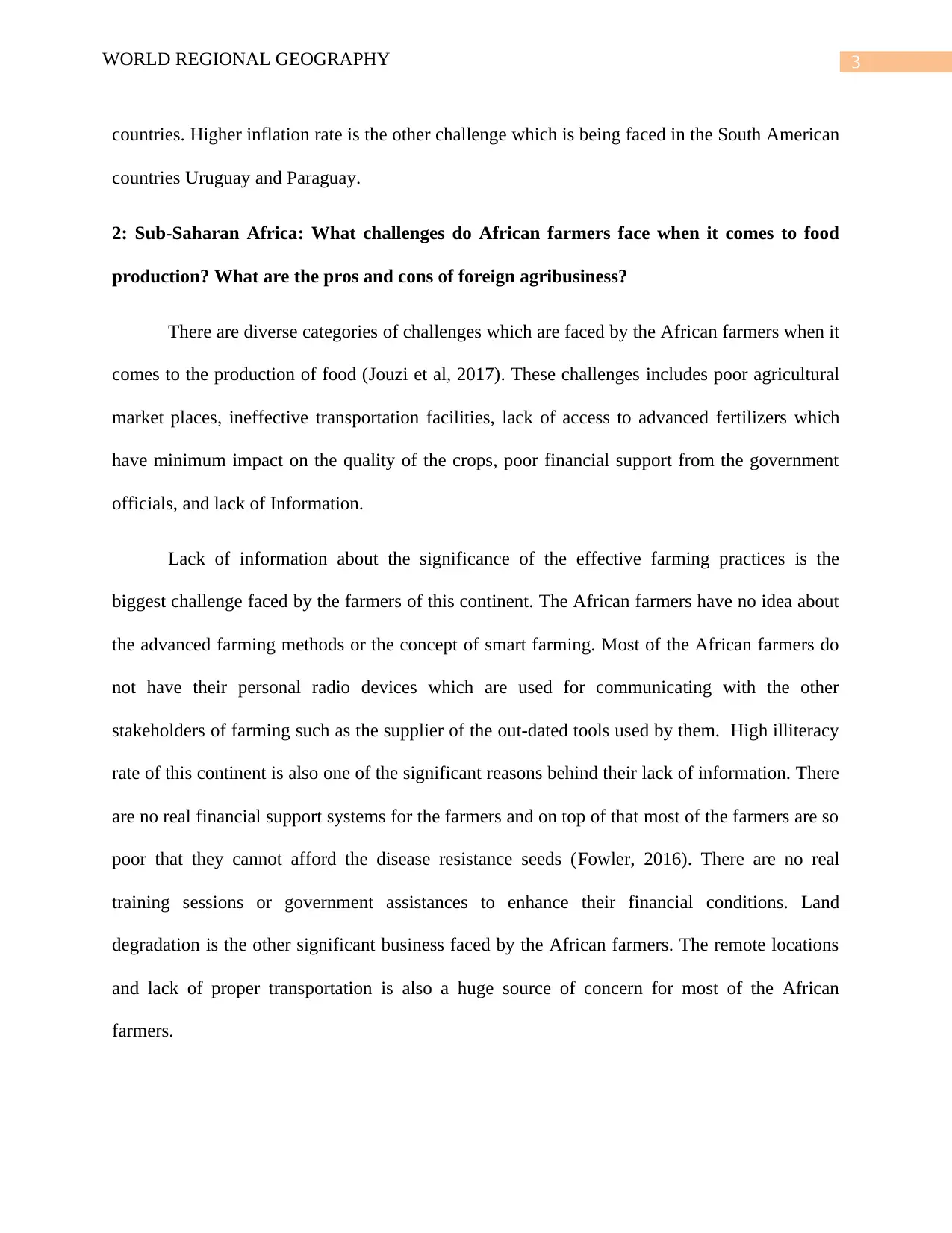
3WORLD REGIONAL GEOGRAPHY
countries. Higher inflation rate is the other challenge which is being faced in the South American
countries Uruguay and Paraguay.
2: Sub-Saharan Africa: What challenges do African farmers face when it comes to food
production? What are the pros and cons of foreign agribusiness?
There are diverse categories of challenges which are faced by the African farmers when it
comes to the production of food (Jouzi et al, 2017). These challenges includes poor agricultural
market places, ineffective transportation facilities, lack of access to advanced fertilizers which
have minimum impact on the quality of the crops, poor financial support from the government
officials, and lack of Information.
Lack of information about the significance of the effective farming practices is the
biggest challenge faced by the farmers of this continent. The African farmers have no idea about
the advanced farming methods or the concept of smart farming. Most of the African farmers do
not have their personal radio devices which are used for communicating with the other
stakeholders of farming such as the supplier of the out-dated tools used by them. High illiteracy
rate of this continent is also one of the significant reasons behind their lack of information. There
are no real financial support systems for the farmers and on top of that most of the farmers are so
poor that they cannot afford the disease resistance seeds (Fowler, 2016). There are no real
training sessions or government assistances to enhance their financial conditions. Land
degradation is the other significant business faced by the African farmers. The remote locations
and lack of proper transportation is also a huge source of concern for most of the African
farmers.
countries. Higher inflation rate is the other challenge which is being faced in the South American
countries Uruguay and Paraguay.
2: Sub-Saharan Africa: What challenges do African farmers face when it comes to food
production? What are the pros and cons of foreign agribusiness?
There are diverse categories of challenges which are faced by the African farmers when it
comes to the production of food (Jouzi et al, 2017). These challenges includes poor agricultural
market places, ineffective transportation facilities, lack of access to advanced fertilizers which
have minimum impact on the quality of the crops, poor financial support from the government
officials, and lack of Information.
Lack of information about the significance of the effective farming practices is the
biggest challenge faced by the farmers of this continent. The African farmers have no idea about
the advanced farming methods or the concept of smart farming. Most of the African farmers do
not have their personal radio devices which are used for communicating with the other
stakeholders of farming such as the supplier of the out-dated tools used by them. High illiteracy
rate of this continent is also one of the significant reasons behind their lack of information. There
are no real financial support systems for the farmers and on top of that most of the farmers are so
poor that they cannot afford the disease resistance seeds (Fowler, 2016). There are no real
training sessions or government assistances to enhance their financial conditions. Land
degradation is the other significant business faced by the African farmers. The remote locations
and lack of proper transportation is also a huge source of concern for most of the African
farmers.
⊘ This is a preview!⊘
Do you want full access?
Subscribe today to unlock all pages.

Trusted by 1+ million students worldwide
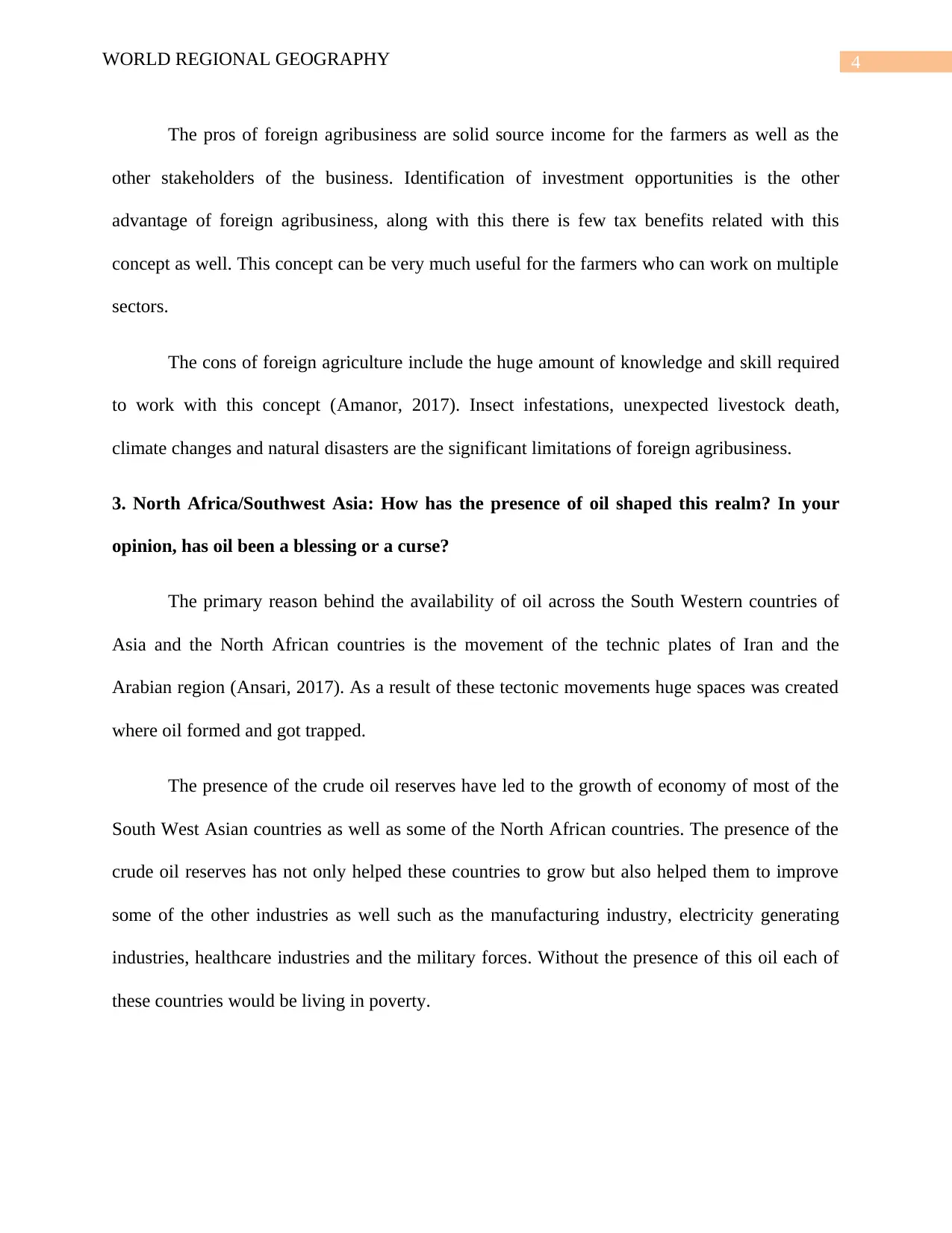
4WORLD REGIONAL GEOGRAPHY
The pros of foreign agribusiness are solid source income for the farmers as well as the
other stakeholders of the business. Identification of investment opportunities is the other
advantage of foreign agribusiness, along with this there is few tax benefits related with this
concept as well. This concept can be very much useful for the farmers who can work on multiple
sectors.
The cons of foreign agriculture include the huge amount of knowledge and skill required
to work with this concept (Amanor, 2017). Insect infestations, unexpected livestock death,
climate changes and natural disasters are the significant limitations of foreign agribusiness.
3. North Africa/Southwest Asia: How has the presence of oil shaped this realm? In your
opinion, has oil been a blessing or a curse?
The primary reason behind the availability of oil across the South Western countries of
Asia and the North African countries is the movement of the technic plates of Iran and the
Arabian region (Ansari, 2017). As a result of these tectonic movements huge spaces was created
where oil formed and got trapped.
The presence of the crude oil reserves have led to the growth of economy of most of the
South West Asian countries as well as some of the North African countries. The presence of the
crude oil reserves has not only helped these countries to grow but also helped them to improve
some of the other industries as well such as the manufacturing industry, electricity generating
industries, healthcare industries and the military forces. Without the presence of this oil each of
these countries would be living in poverty.
The pros of foreign agribusiness are solid source income for the farmers as well as the
other stakeholders of the business. Identification of investment opportunities is the other
advantage of foreign agribusiness, along with this there is few tax benefits related with this
concept as well. This concept can be very much useful for the farmers who can work on multiple
sectors.
The cons of foreign agriculture include the huge amount of knowledge and skill required
to work with this concept (Amanor, 2017). Insect infestations, unexpected livestock death,
climate changes and natural disasters are the significant limitations of foreign agribusiness.
3. North Africa/Southwest Asia: How has the presence of oil shaped this realm? In your
opinion, has oil been a blessing or a curse?
The primary reason behind the availability of oil across the South Western countries of
Asia and the North African countries is the movement of the technic plates of Iran and the
Arabian region (Ansari, 2017). As a result of these tectonic movements huge spaces was created
where oil formed and got trapped.
The presence of the crude oil reserves have led to the growth of economy of most of the
South West Asian countries as well as some of the North African countries. The presence of the
crude oil reserves has not only helped these countries to grow but also helped them to improve
some of the other industries as well such as the manufacturing industry, electricity generating
industries, healthcare industries and the military forces. Without the presence of this oil each of
these countries would be living in poverty.
Paraphrase This Document
Need a fresh take? Get an instant paraphrase of this document with our AI Paraphraser
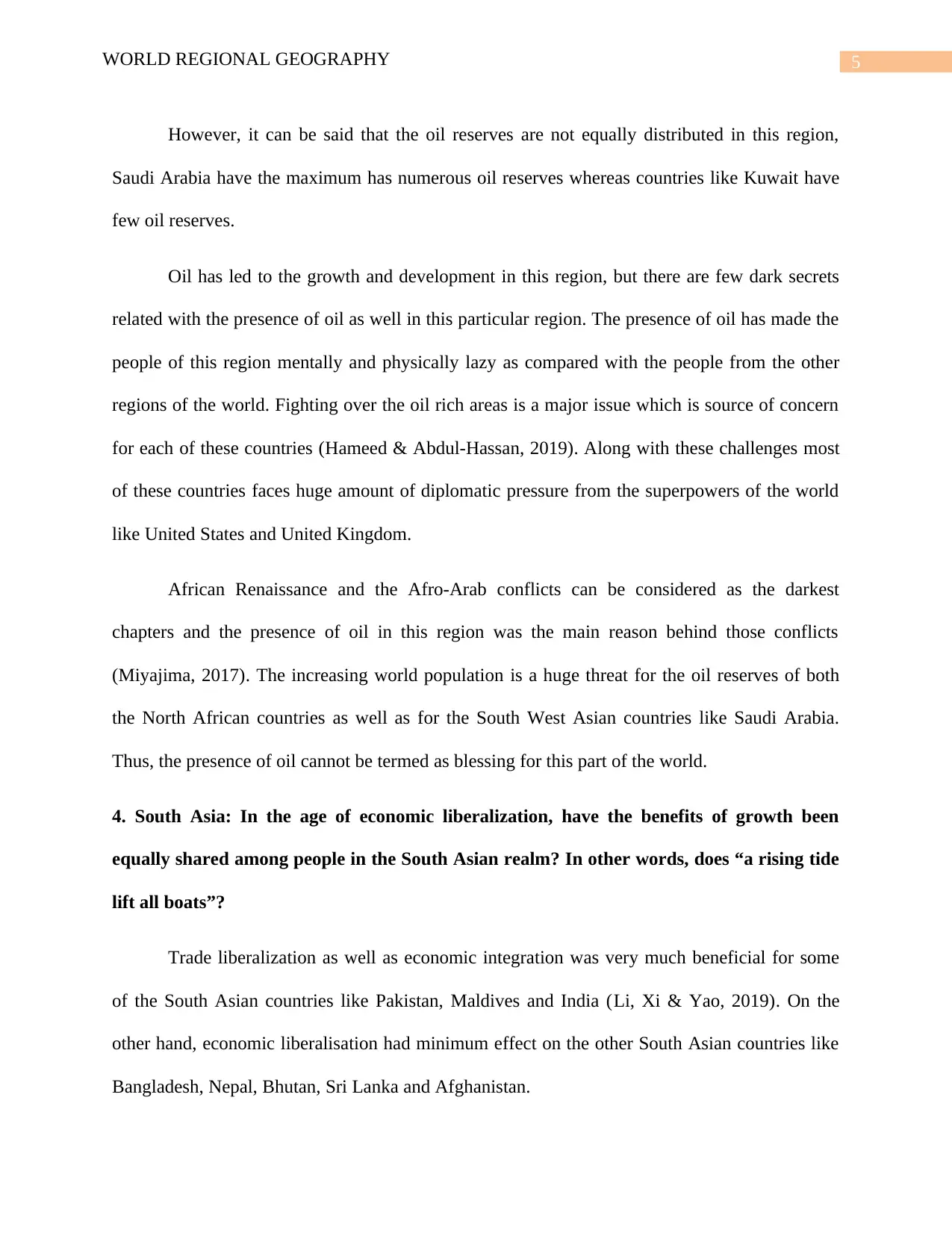
5WORLD REGIONAL GEOGRAPHY
However, it can be said that the oil reserves are not equally distributed in this region,
Saudi Arabia have the maximum has numerous oil reserves whereas countries like Kuwait have
few oil reserves.
Oil has led to the growth and development in this region, but there are few dark secrets
related with the presence of oil as well in this particular region. The presence of oil has made the
people of this region mentally and physically lazy as compared with the people from the other
regions of the world. Fighting over the oil rich areas is a major issue which is source of concern
for each of these countries (Hameed & Abdul-Hassan, 2019). Along with these challenges most
of these countries faces huge amount of diplomatic pressure from the superpowers of the world
like United States and United Kingdom.
African Renaissance and the Afro-Arab conflicts can be considered as the darkest
chapters and the presence of oil in this region was the main reason behind those conflicts
(Miyajima, 2017). The increasing world population is a huge threat for the oil reserves of both
the North African countries as well as for the South West Asian countries like Saudi Arabia.
Thus, the presence of oil cannot be termed as blessing for this part of the world.
4. South Asia: In the age of economic liberalization, have the benefits of growth been
equally shared among people in the South Asian realm? In other words, does “a rising tide
lift all boats”?
Trade liberalization as well as economic integration was very much beneficial for some
of the South Asian countries like Pakistan, Maldives and India (Li, Xi & Yao, 2019). On the
other hand, economic liberalisation had minimum effect on the other South Asian countries like
Bangladesh, Nepal, Bhutan, Sri Lanka and Afghanistan.
However, it can be said that the oil reserves are not equally distributed in this region,
Saudi Arabia have the maximum has numerous oil reserves whereas countries like Kuwait have
few oil reserves.
Oil has led to the growth and development in this region, but there are few dark secrets
related with the presence of oil as well in this particular region. The presence of oil has made the
people of this region mentally and physically lazy as compared with the people from the other
regions of the world. Fighting over the oil rich areas is a major issue which is source of concern
for each of these countries (Hameed & Abdul-Hassan, 2019). Along with these challenges most
of these countries faces huge amount of diplomatic pressure from the superpowers of the world
like United States and United Kingdom.
African Renaissance and the Afro-Arab conflicts can be considered as the darkest
chapters and the presence of oil in this region was the main reason behind those conflicts
(Miyajima, 2017). The increasing world population is a huge threat for the oil reserves of both
the North African countries as well as for the South West Asian countries like Saudi Arabia.
Thus, the presence of oil cannot be termed as blessing for this part of the world.
4. South Asia: In the age of economic liberalization, have the benefits of growth been
equally shared among people in the South Asian realm? In other words, does “a rising tide
lift all boats”?
Trade liberalization as well as economic integration was very much beneficial for some
of the South Asian countries like Pakistan, Maldives and India (Li, Xi & Yao, 2019). On the
other hand, economic liberalisation had minimum effect on the other South Asian countries like
Bangladesh, Nepal, Bhutan, Sri Lanka and Afghanistan.
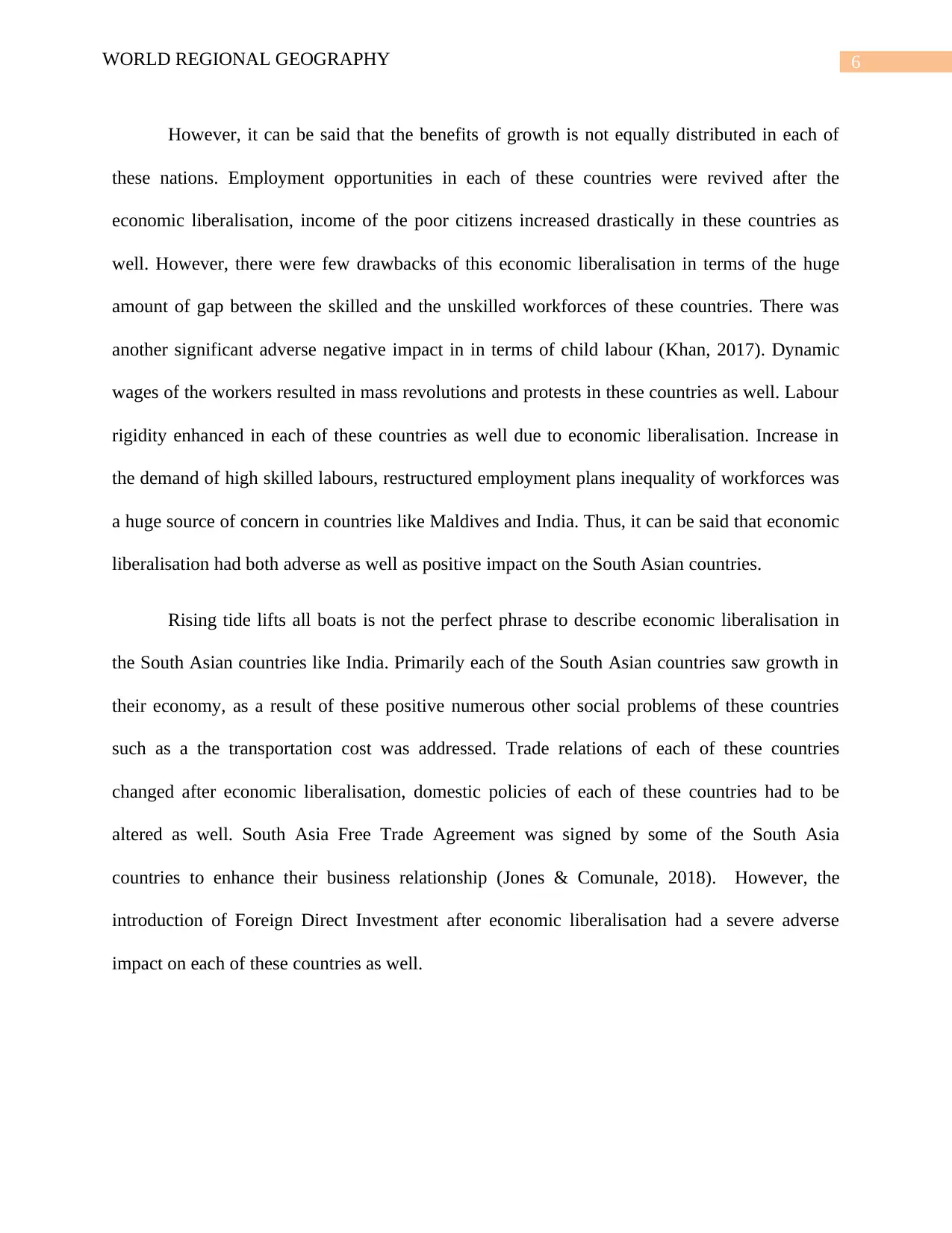
6WORLD REGIONAL GEOGRAPHY
However, it can be said that the benefits of growth is not equally distributed in each of
these nations. Employment opportunities in each of these countries were revived after the
economic liberalisation, income of the poor citizens increased drastically in these countries as
well. However, there were few drawbacks of this economic liberalisation in terms of the huge
amount of gap between the skilled and the unskilled workforces of these countries. There was
another significant adverse negative impact in in terms of child labour (Khan, 2017). Dynamic
wages of the workers resulted in mass revolutions and protests in these countries as well. Labour
rigidity enhanced in each of these countries as well due to economic liberalisation. Increase in
the demand of high skilled labours, restructured employment plans inequality of workforces was
a huge source of concern in countries like Maldives and India. Thus, it can be said that economic
liberalisation had both adverse as well as positive impact on the South Asian countries.
Rising tide lifts all boats is not the perfect phrase to describe economic liberalisation in
the South Asian countries like India. Primarily each of the South Asian countries saw growth in
their economy, as a result of these positive numerous other social problems of these countries
such as a the transportation cost was addressed. Trade relations of each of these countries
changed after economic liberalisation, domestic policies of each of these countries had to be
altered as well. South Asia Free Trade Agreement was signed by some of the South Asia
countries to enhance their business relationship (Jones & Comunale, 2018). However, the
introduction of Foreign Direct Investment after economic liberalisation had a severe adverse
impact on each of these countries as well.
However, it can be said that the benefits of growth is not equally distributed in each of
these nations. Employment opportunities in each of these countries were revived after the
economic liberalisation, income of the poor citizens increased drastically in these countries as
well. However, there were few drawbacks of this economic liberalisation in terms of the huge
amount of gap between the skilled and the unskilled workforces of these countries. There was
another significant adverse negative impact in in terms of child labour (Khan, 2017). Dynamic
wages of the workers resulted in mass revolutions and protests in these countries as well. Labour
rigidity enhanced in each of these countries as well due to economic liberalisation. Increase in
the demand of high skilled labours, restructured employment plans inequality of workforces was
a huge source of concern in countries like Maldives and India. Thus, it can be said that economic
liberalisation had both adverse as well as positive impact on the South Asian countries.
Rising tide lifts all boats is not the perfect phrase to describe economic liberalisation in
the South Asian countries like India. Primarily each of the South Asian countries saw growth in
their economy, as a result of these positive numerous other social problems of these countries
such as a the transportation cost was addressed. Trade relations of each of these countries
changed after economic liberalisation, domestic policies of each of these countries had to be
altered as well. South Asia Free Trade Agreement was signed by some of the South Asia
countries to enhance their business relationship (Jones & Comunale, 2018). However, the
introduction of Foreign Direct Investment after economic liberalisation had a severe adverse
impact on each of these countries as well.
⊘ This is a preview!⊘
Do you want full access?
Subscribe today to unlock all pages.

Trusted by 1+ million students worldwide
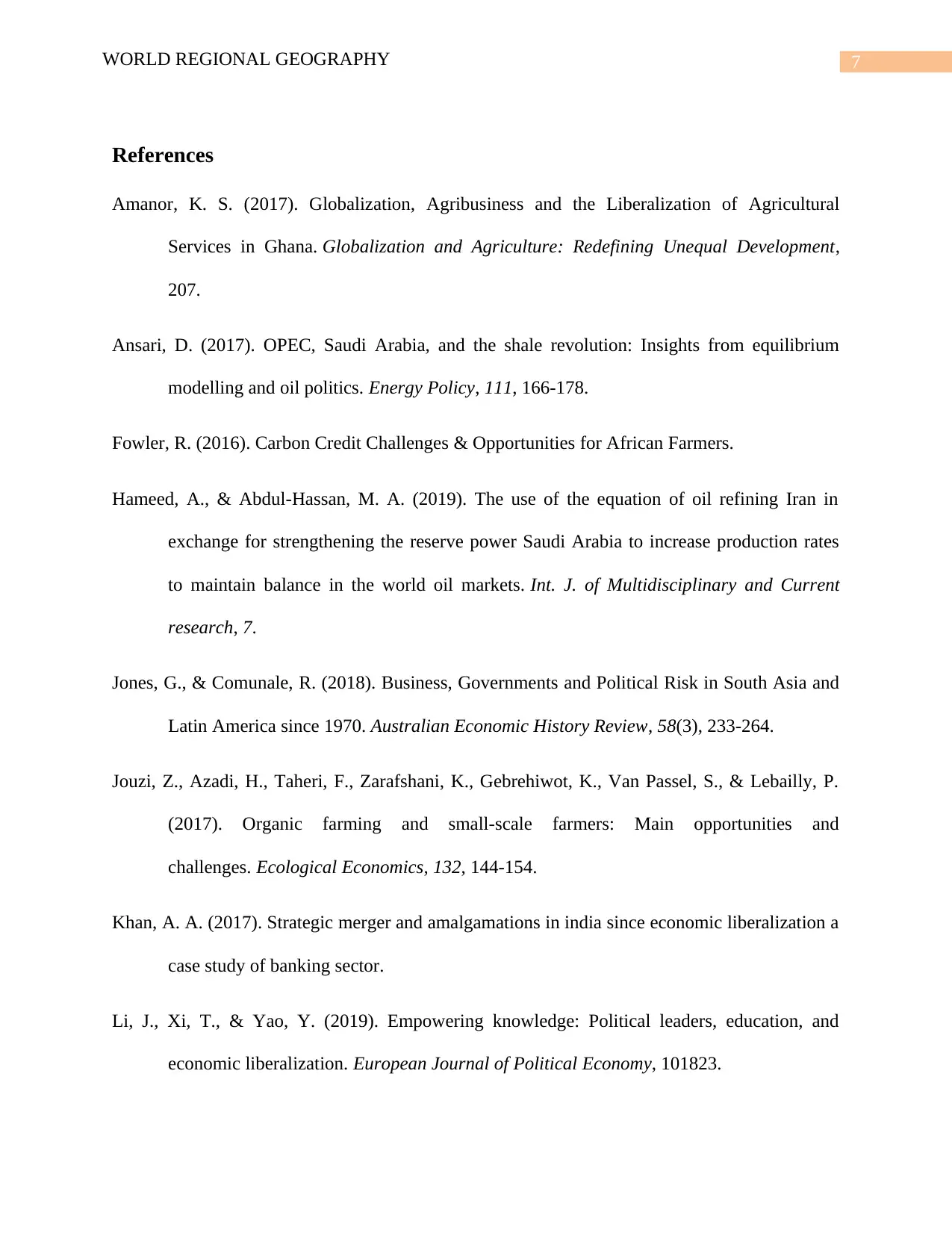
7WORLD REGIONAL GEOGRAPHY
References
Amanor, K. S. (2017). Globalization, Agribusiness and the Liberalization of Agricultural
Services in Ghana. Globalization and Agriculture: Redefining Unequal Development,
207.
Ansari, D. (2017). OPEC, Saudi Arabia, and the shale revolution: Insights from equilibrium
modelling and oil politics. Energy Policy, 111, 166-178.
Fowler, R. (2016). Carbon Credit Challenges & Opportunities for African Farmers.
Hameed, A., & Abdul-Hassan, M. A. (2019). The use of the equation of oil refining Iran in
exchange for strengthening the reserve power Saudi Arabia to increase production rates
to maintain balance in the world oil markets. Int. J. of Multidisciplinary and Current
research, 7.
Jones, G., & Comunale, R. (2018). Business, Governments and Political Risk in South Asia and
Latin America since 1970. Australian Economic History Review, 58(3), 233-264.
Jouzi, Z., Azadi, H., Taheri, F., Zarafshani, K., Gebrehiwot, K., Van Passel, S., & Lebailly, P.
(2017). Organic farming and small-scale farmers: Main opportunities and
challenges. Ecological Economics, 132, 144-154.
Khan, A. A. (2017). Strategic merger and amalgamations in india since economic liberalization a
case study of banking sector.
Li, J., Xi, T., & Yao, Y. (2019). Empowering knowledge: Political leaders, education, and
economic liberalization. European Journal of Political Economy, 101823.
References
Amanor, K. S. (2017). Globalization, Agribusiness and the Liberalization of Agricultural
Services in Ghana. Globalization and Agriculture: Redefining Unequal Development,
207.
Ansari, D. (2017). OPEC, Saudi Arabia, and the shale revolution: Insights from equilibrium
modelling and oil politics. Energy Policy, 111, 166-178.
Fowler, R. (2016). Carbon Credit Challenges & Opportunities for African Farmers.
Hameed, A., & Abdul-Hassan, M. A. (2019). The use of the equation of oil refining Iran in
exchange for strengthening the reserve power Saudi Arabia to increase production rates
to maintain balance in the world oil markets. Int. J. of Multidisciplinary and Current
research, 7.
Jones, G., & Comunale, R. (2018). Business, Governments and Political Risk in South Asia and
Latin America since 1970. Australian Economic History Review, 58(3), 233-264.
Jouzi, Z., Azadi, H., Taheri, F., Zarafshani, K., Gebrehiwot, K., Van Passel, S., & Lebailly, P.
(2017). Organic farming and small-scale farmers: Main opportunities and
challenges. Ecological Economics, 132, 144-154.
Khan, A. A. (2017). Strategic merger and amalgamations in india since economic liberalization a
case study of banking sector.
Li, J., Xi, T., & Yao, Y. (2019). Empowering knowledge: Political leaders, education, and
economic liberalization. European Journal of Political Economy, 101823.
Paraphrase This Document
Need a fresh take? Get an instant paraphrase of this document with our AI Paraphraser
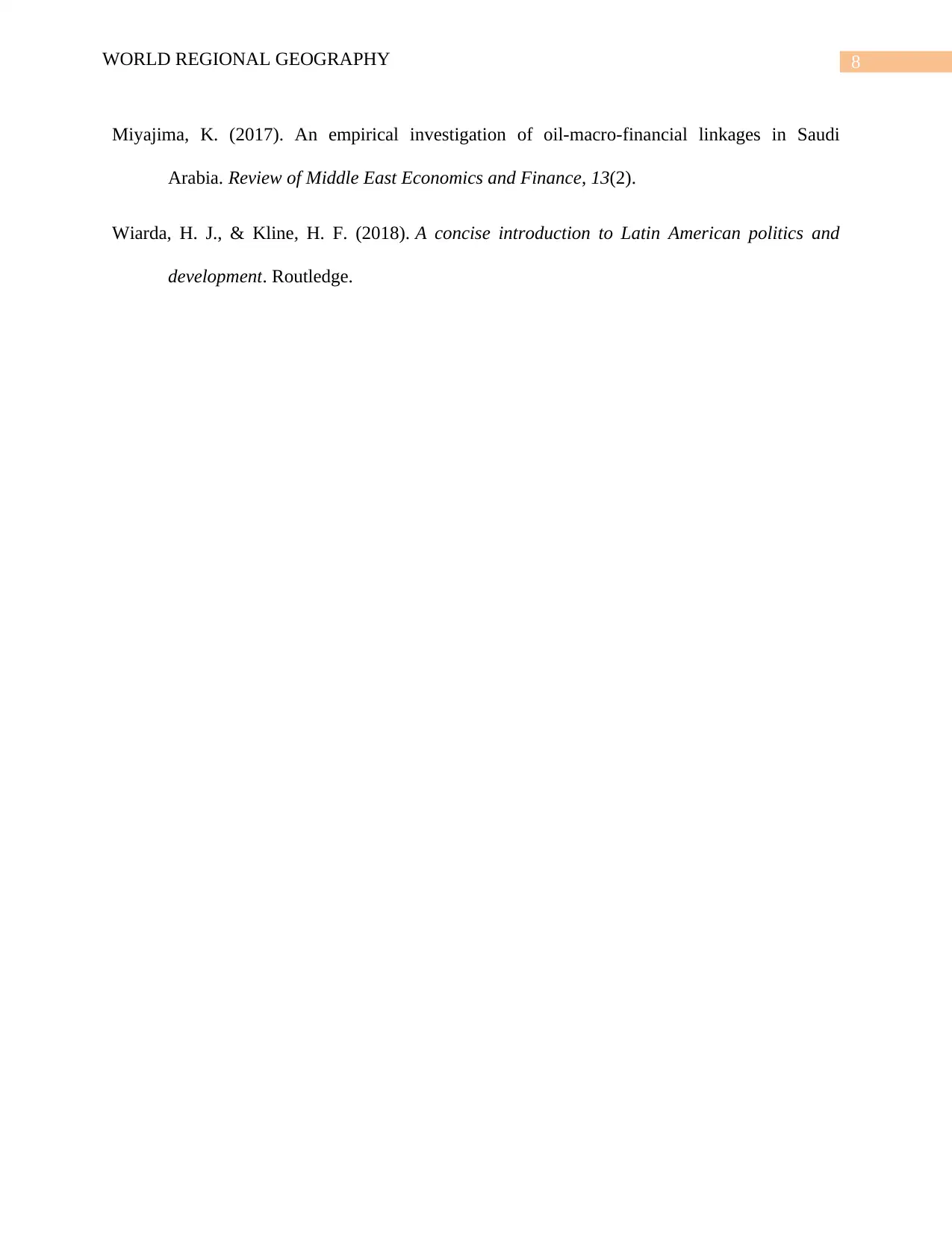
8WORLD REGIONAL GEOGRAPHY
Miyajima, K. (2017). An empirical investigation of oil-macro-financial linkages in Saudi
Arabia. Review of Middle East Economics and Finance, 13(2).
Wiarda, H. J., & Kline, H. F. (2018). A concise introduction to Latin American politics and
development. Routledge.
Miyajima, K. (2017). An empirical investigation of oil-macro-financial linkages in Saudi
Arabia. Review of Middle East Economics and Finance, 13(2).
Wiarda, H. J., & Kline, H. F. (2018). A concise introduction to Latin American politics and
development. Routledge.
1 out of 8
Related Documents
Your All-in-One AI-Powered Toolkit for Academic Success.
+13062052269
info@desklib.com
Available 24*7 on WhatsApp / Email
![[object Object]](/_next/static/media/star-bottom.7253800d.svg)
Unlock your academic potential
Copyright © 2020–2025 A2Z Services. All Rights Reserved. Developed and managed by ZUCOL.




